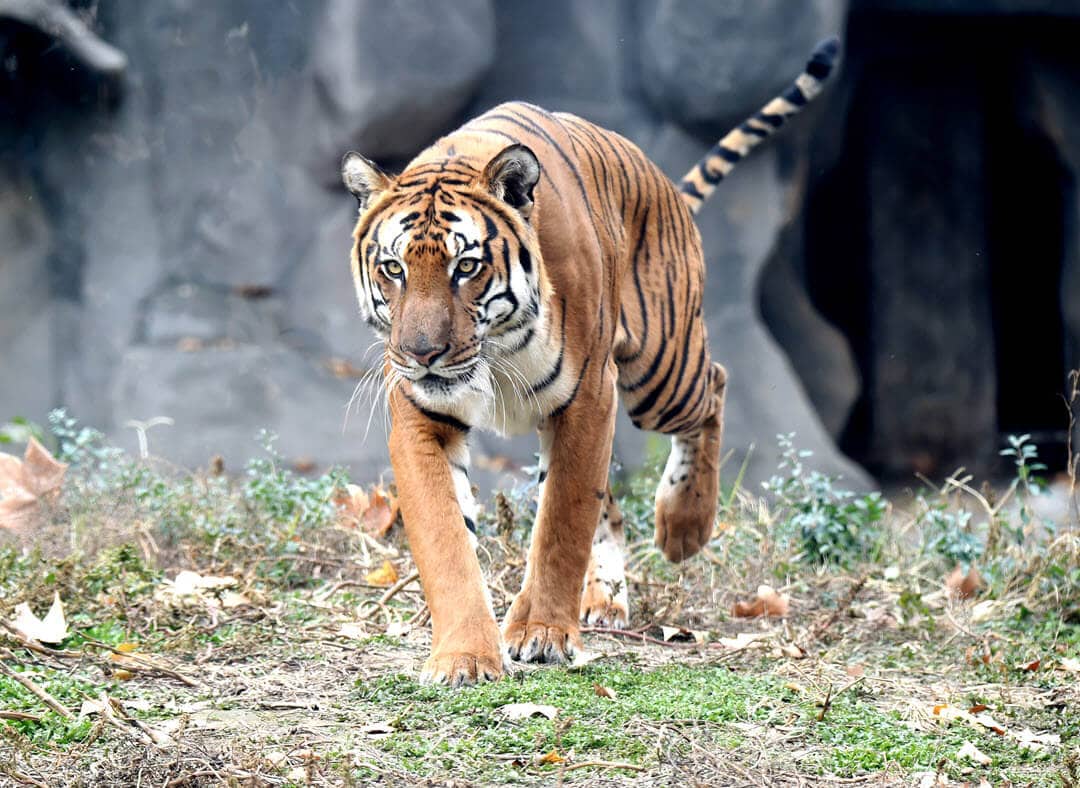The South China tiger inhabits southern China. It is the rarest tiger species and extinct in the wild.
Classification: A population of Panthera tigris tigris
Panthera tigris tigris is the nominate tiger subspecies – the original population of a species that has been split into subspecies. Within the Panthera tigris tigris subspecies, the South China tiger is currently considered a clade – a group descended from a single ancestor. The Malayan, Indochinese, Bengal, and Siberian tigers are also separate clades (populations) within this subspecies. (Note: tiger species taxonomy is currently under review by the IUCN SSC Cat Specialist Group.)
Conservation Status: Critically Endangered, possibly extinct.
Lineage: The South China tiger is a member of the Panthera lineage, along with other tigers, the lion, leopard, sunda clouded leopard and snow leopard. There are two genera in this lineage: Panthera and Neofelis.
More about the South China tiger
The South China tiger is the smallest tiger in mainland Asia, but larger than the Sumatran tiger.
During the early 1950s, the wild population of South China tigers was estimated at around 4,000 individuals. Today there is only a captive population of South China tigers.
Origin and history
The South China tiger appeared in China approximately 2 million years ago and is believed to be the most ancient of all tiger subspecies.
Many thousands of years ago, in the late Pleistocene era, the South China tiger likely interacted with Siberian tigers through Yellow River basin corridors. The Yellow River basin, also known as the cradle of Chinese civilization, is located in northern and central China. It extends 1,180 miles east and west and 680 miles north and south.
Physical appearance
The South China tiger has lighter-colored fur than most tigers and an even lighter, almost white underbelly. It has many narrow stripes with sharp edges.
Males are 91 to 104 inches in length and weigh between 287 and 386 lbs. Females are smaller—87 to 94 inches long and weigh 220 to 254 lbs.
Location and habitat
The tiger’s range used to stretch over a large area in China, from east to west and north to south. It is now listed as Critically Endangered and possibly extinct since no wild South China tiger has been seen since the late 1980s.
South China tiger behavior
The South China tiger leads a solitary life, except during mating season. Sometimes, the territories of males overlap.
Mating and reproduction
Male tigers can mate all year long, but the peak period is usually from November to April. Offspring are born within 3.5 months of mating. The litter size is usually around 3 to 6 cubs. The cubs are taught to hunt around six months of age and become independent after 1 1/2 to 2 years.
Hunting and prey
The South China tiger preys on deer, boar, and ungulates (large mammals with hooves). Its diet can also include rabbits, porcupines, and peafowl.
They kill their prey with a bite to the neck and drag the carcass to a safe place to eat.
Domestic livestock has also been attacked.
South China tiger conservation
Beginning in the late 1950s, a government program was implemented that labeled the cat a pest, resulting in excessive hunting. Other factors that contributed to declining populations include deforestation and habitat loss/fragmentation.
By the late 1980s, the tiger population was estimated at only 30 to 40 individuals. No evidence of the tiger was found as of a 2001 field study conducted in eight protected areas.program.
In 1994, the Chiense Association of Zoological Gardens began a captive breeding program.
In 2007, The Chines government stated an intention to reintroduce the South China tiger to the wild. Save China’s Tigers is a charity working with the Chinese government and other nonprofits to “restore and protect biodiversity for the reintroduction of a genetically viable population of free-ranging South China tigers in suitable ptorected reserves in their former range in China.”
There are an estimated 150 – 200 South China tigers in captivity and breeding programs.
References and quotes
“The South China tiger holds a place of honor in China—as a cultural icon in art, literature, and philosophy, as a symbol of wilderness to promote a new conservation ethic amid an expanding human population, and as a source of national pride as the only uniquely Chinese tiger subspecies. Early in its history, the captive South China tiger population flourished. By 1990, the pedigree represented several generations in captivity, gene diversity begin to decline, and inbreeding levels averaged over 20%. ” 2010 Tigers of the Wild – The Struggle to Save the Last South China Tigers | Traylor-Holzer
“The South China tiger (Panthera tigris amoyensis) is endemic to China and also the most critically endangered subspecies of living tigers. It is considered extinct in the wild and only about 150 individuals survive in captivity to date, whose genetic heritage, however, is ambiguous and controversial.” 2019 Sorting Out the Genetic Background of the Last Surviving South China Tigers | Zhang, Xu, et al.
“In the 1950s, around 4000 South China tigers were found in 13 provinces in China. Unfortunately, up to 3000 tigers were hunted as a pest and killed mercilessly during that period. Habitat loss/fragmentation further accelerated the decline of these tigers. Only in 1979, the Chinese government banned the hunting of the tigers, whereas the number of the South China tiger was estimated to be only 30–80 in 1996. No South China tiger was directly sighted in the wild since the 1990s. it was therefore believed to be “functionally extinct” by many scientists, followed by an official declaration of its extinction in the wild in 2012. Considerable efforts have been made to rescue the South China tiger through a captive breeding program in China.” 2023 Population genomic analysis provides evidence of the past success and future potential of South China tiger captive conservation | Wang, Wu et al.


















0 Comments